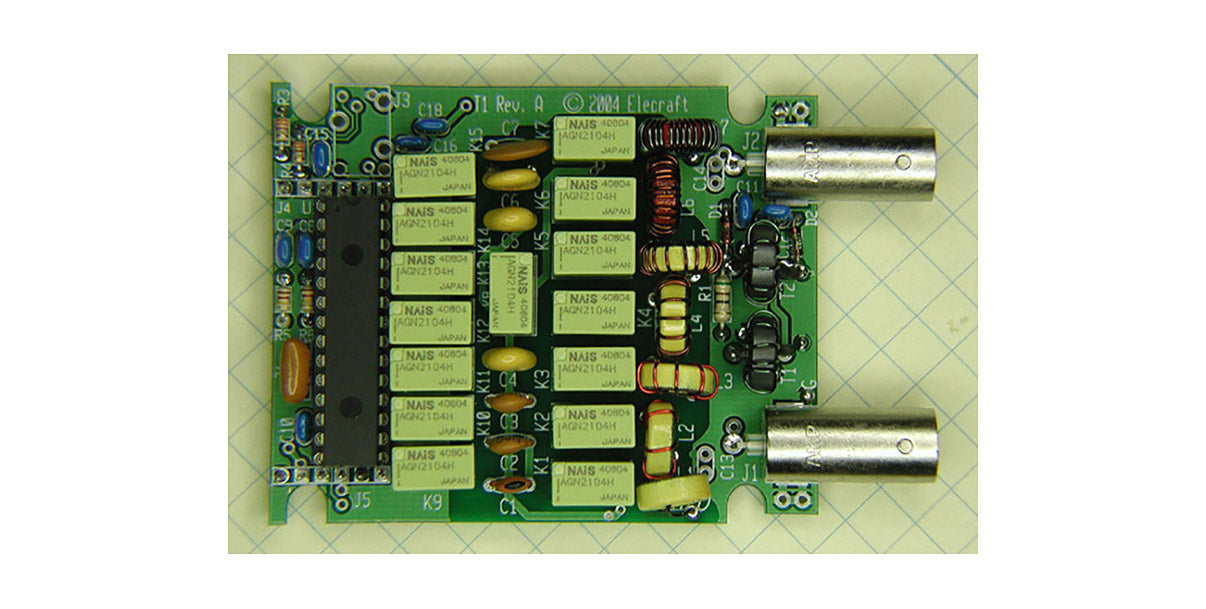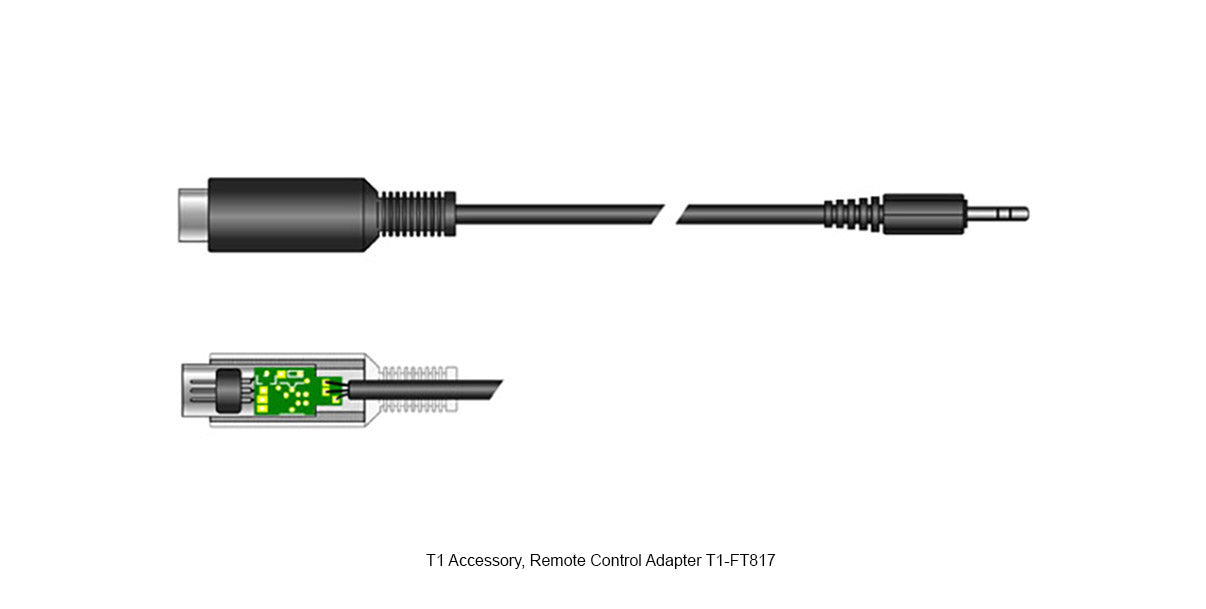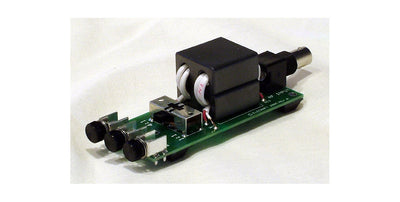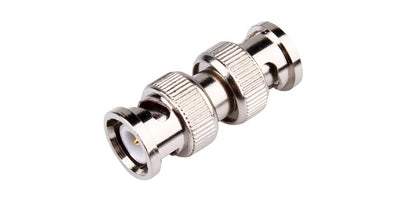T1 ANTENNA TUNER, ASSEMBLED, $20 DISCOUNT + FREE SHIPPING!
World's Smallest Stand-Alone ATU!
The Elecraft T1 is the only automatic antenna tuner that's sized to match today's small QRP rigs. It's one-fourth the size of most other compact ATUs. And at just 5 ounces, the T1 is the ideal backpacking accessory.
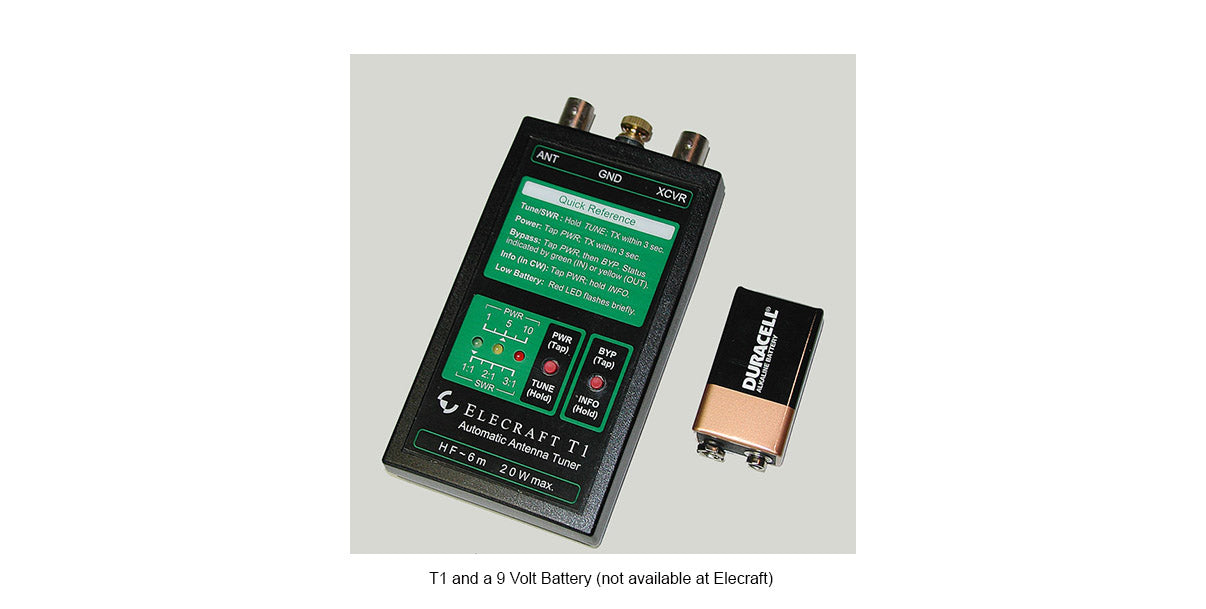
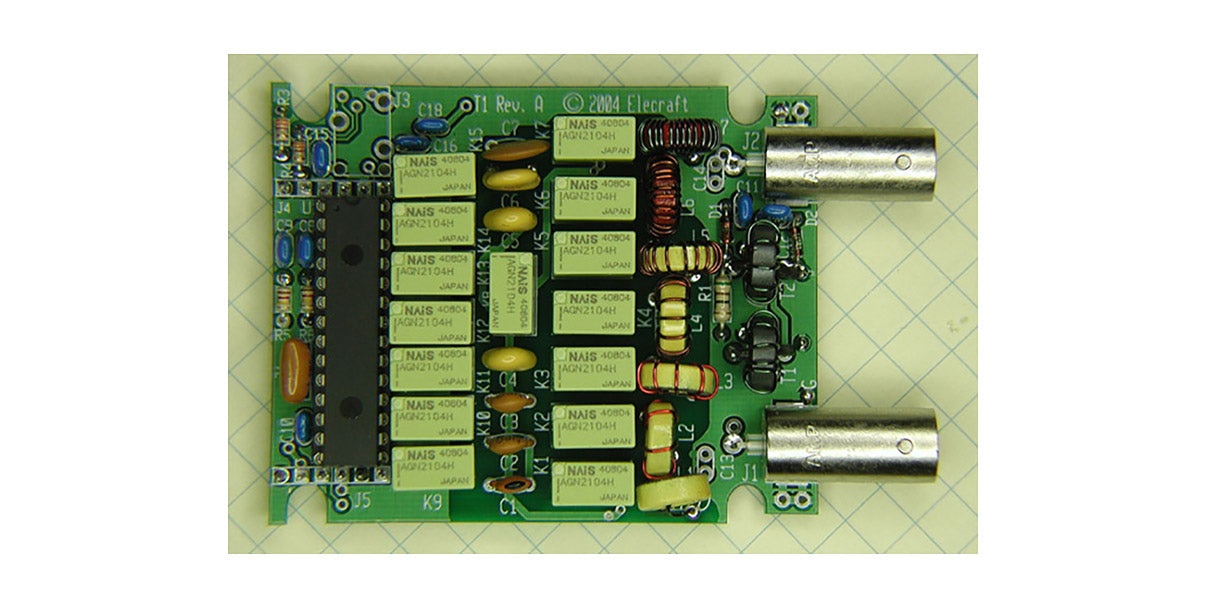
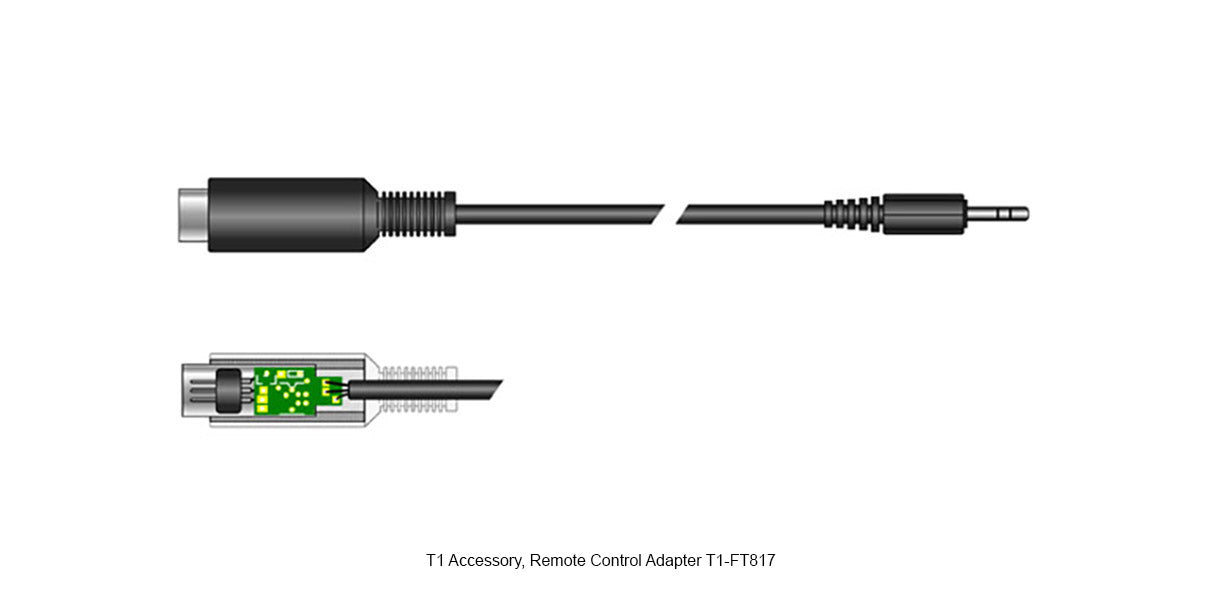
- Overview
- Specs
- Accessories
- Reviews
- FAQ
- Manuals & Downloads
- Price List/Order
OVERVIEW
Use with any Low-Power Transceiver
The T1 can be used with any 0.5-W to 20-W transceiver covering bands in the 160-6 m range. This includes kits, home-built rigs, and commercial transceivers such as the FT-817, IC703, Ten-Tec Argonaut, SG2020, etc.
Quick, Convenient, and Accurate
The T1's 7-inductor, 7-capacitor L-network provides a wide matching range, and its re-tune time from memory is just 1 to 2 seconds. Equally important, the T1 always tries to achieve a 1.0:1 SWR-it doesn't stop at 1.5:1 or 2.0:1 like some tuners. You won't even need to change modes to tune. You can use SSB voice or a keyer as well as a constant carrier (AM, FM, CW, etc.).
FT-817 Remote-Control Option
For even greater convenience, we offer a "smart" remote control adapter for use with the Yaesu FT-817 . On any band change, the adapter's microcontroller sends band data to the T1, which quickly recalls the appropriate network settings. Imagine instant QSY without the need to transmit-less QRM, less hassle! (See drawing below.)
Factory-Assembled or Complete Kit
You can purchase the T1 assembled and tested, or as an easy-to-build kit. Our professionally written, fully illustrated assembly manual provides step-by-step instructions, and no alignment is required.
Unsurpassed Technical Support
If you have any difficulty, our technical support via telephone and the Internet will get your T1 up and running quickly. You can also get answers to nearly any question day or night from the helpful, tech-savvy hams on our e-mail user group.
SPECS
- Inductance range: 0-7.5 μH in 128 steps
- Capacitance range: 0-1300 pF in 128 steps
- Network: Series L, shunt C (switchable)
- Tuning times (typical): 2 to 8 seconds for initial tuning; 1 to 2 seconds to re-tune from memory
- Frequency range: 1.8 to 54 MHz
- Max power: 20 W peak, 10 W continuous (10 W peak on 6 meters)
- SWR/power display: 1:1 to 3:1 and 0.5 to 10 watts on three LEDs (5 gradations)
- Supply voltage: 8 to 10 VDC; 9-volt Ultralife lithium or alkaline battery recommended
- Current drain: 20 mA average during TUNE; 0 mA when off (auto power-off)
- Size: 4.4 x 2.5 x 0.9" (11.2 x 6.3 x 2.3 cm)
- Weight: 5 oz. (0.14 kg)
Additional Features
- Small size, ideal for home, mobile, camping, and HF Pack use
- Stand-alone; works with any low-power rig
- 160 through 6 meter coverage
- Handles up to 20 watts (10 W continuous)
- Finds lowest SWR; doesn't stop at 1.5:1 or 2:1
- Tunes in any mode (constant carrier, SSB voice, CW keying, AM, FM, packet, etc.)
- Many tune-ups are saved for fast re-tuning
FAQ
Q: How does the T1 compare to the KAT2, KAT1, and KXAT1?
A: The T1 is intended for stand-alone use (with all QRP kits, home-built rigs, and factory-assembled transceivers such as the Yaesu FT-817, Icom IC-703, Ten-Tec Argonaut, and SG2020). It also includes coverage of 6 meters. In contrast, our other QRP ATUs are fully integrated with specific Elecraft HF transceivers, providing internal installation, instant ATU band switching, menu access to ATU information, and additional features.For example, the KAT2 has dual antenna jacks, per-antenna memories, direct readout of power or SWR on the
Q: What's the lowest power recommended for use with the T1?
A: We recommend using 2 to 5 watts for initial tune-ups. But the T1 will auto-tune with as little as 0.5 watts, so it can be used effectively with nearly all available QRP rigs. If you want to do "milliwatting" with the T1, you may need to tune up at higher power first, then drop your transmitter's power during actual operation.
Q: Can the T1 be built inside a Sierra, FT-817, or other transceiver?
A: Yes. The PC board is only about 2 by 3 inches, so it could be built into just about any rig. With some effort, the T1 could be installed inside the battery compartment of the FT-817. In the case of a Sierra, you could mount the T1 in the Sierra's top cover so that the switches and LEDs were accessible, then aim the BNC jacks out the back by cutting U-shaped channels down from the top. This is an ideal ATU for either rig, and it has been extensively tested with both (not to mention the K2, K1, and KX1).
Q: What modes can I use to tune the T1?
A: The T1 will tune using SSB voice or CW keying as well as a constant carrier (AM, FM, CW, packet, etc.). In the case of SSB voice, the ATU samples and averages peak voice power to establish a threshold that ensures accurate SWR measurement. Of course a constant carrier will reduce initial tune times compared to an intermittent voice or CW keyer waveform. But thanks to the T1's memories, re-tunes typically take just 1 to 2 seconds in any mode.
Q: Many stand-alone ATUs stop tuning when they reach 1.5:1. How about the T1?
A: The T1 always tries to hit 1.0:1, and usually gets pretty close. This ensures maximum power transfer and takes best advantage of the low-pass characteristics of an L-network. Sometimes this extra effort to hit 1.0:1 means that the T1 will take a little longer to find a match, but finding the best match is usually more important than saving a couple of seconds on an initial tune.
Q: Does the T1 have memories?
A: Yes. The T1 saves a large number of L-C settings from previous tune-ups, then tries these first when you start a TUNE operation. This cuts typical re-tune times to about 1 to 2 seconds.
Q: Can an automatic antenna tuner be safely used with all low-power rigs?
A: The vast majority of commercial, kit, and home-built transmitters have some form of protection from high SWR. This is important when using either a manual or automatic antenna tuner, because a wide range of impedances is presented to the final stage during tuning. SWR protection is often mentioned in the specifications or theory of operation section of a transceiver manual. If not, take a look at the schematic. If the transmitter includes ALC, current limiting, or voltage limiting (i.e., a zener diode at the PA collector), chances are it can be used at full power during auto-tuning. If you're not sure, do auto-tuning using no more than half the rig's maximum power output. Small transceivers of many types have been extensively tested at full power with the T1.
Q: Does the T1 automatically re-tune when it senses high SWR?
A: No. We've found that this causes problems in some matching situations, and can drain the battery much more rapidly. Instead, the T1 re-tunes only when you want it to-either by holding the TUNE button or by transmitting within a few seconds of changing bands (if you have a remote-control adapter).
Q: Will the T1 work with short whips such as you'd use for HF Pack or mobile operation?
A: Yes; it will usually extend the range of electrically short antennas to cover the entire nominal band and possibly nearby bands, too (without a coil or segment length adjustment). But these antennas can be very narrow-banded and/or inefficient, so longer antennas are generally preferred when available. Please refer to the "Antenna Recommendations" section of the T1 Owner's Manual, which you can download from our web site.
Q: Can the T1 be used as a remote tuner?
A: The T1 is intended for use near the operating position. But with a little effort it could be remoted, and its extremely small size would be beneficial for this purpose. First, the tuner must be placed in a weatherproof container if used outdoors. Second, controlling the tuner remotely requires a shielded control cable back to the operating position; this cable must supply, at minimum, a simple switch closure to wake up the tuner. It's also possible to create your own band-data interface from the rig to the ATU, as explained in the T1 Owner's Manual. Finally, you'll need an SWR bridge at the operating position since you won't be able to see the LEDs on the T1.
Q: How long will the T1's battery last?
A: That depends on the battery type and how often you change bands or re-tune. Every effort was made to keep current drain low: we used latching relays, which draw no current once they're switched, and the T1 turns itself completely off when not tuning. Even with frequent use, an alkaline battery should last for many months, while a lithium ("Ultralife") battery should last for well over a year. The T1 checks the battery voltage on every power-up and will warn you when it starts getting low.
Q: Is the T1 suitable for backpacking?
A: Yes-and it will save a lot of room and weight in your pack. It's just 4.4 by 2.5 by 0.9", which is about one-fourth the size of other small ATUs and half the size of small manual tuners. Even more important for hikers is that it weighs only 5 ounces, including the internal battery. The closest competing ATU weighs three times as much.
Q: How can I protect the T1 and its controls during travel or backpacking?
A: The T1 is very rugged, so there's no need to pack it inside a separate travel container. Also, if the T1 gets turned on accidentally, it will shut itself off after just a few seconds. However, to prevent the T1 from ever getting turned on during transport, we recommend flipping the battery around so it doesn't make contact. This takes just a few seconds thanks to the integrated 9-V battery compartment and molded-in battery clips; there are no wires to deal with. (The T1 also includes reverse-polarity protection, so no damage will occur if you put the battery in backwards.)
Q: Are there any surface-mount parts in the kit version of the T1?
A: No. The T1 kit uses all through-hole parts, so it's easy to build. You'll need a temperature-controlled soldering iron with a fine tip, and flush-cutters for close trimming of component leads. Tools and soldering techniques are discussed in the professionally written, illustrated assembly manual.
Q: Why are you offering a special remote-control adapter for the FT-817?
A: The T1- FT817 is popular with HF Pack operators, who sometimes hop among designated frequencies on different bands. Our remote-control adapter (model T1-FT817) monitors the rig's band-data output signal so the proper L and C settings for the ATU can be recalled instantly on any band change, without transmitting. This reduces QRM and conserves both tuner and transceiver battery life. We may offer similar interfaces for other low-power rigs in the future.
Q: Why isn't the optional T1-FT817 remote-control adapter available as a kit?
A: We're only offering the T1-FT817 adapter assembled because it includes a very small PC board with 0402-size surface-mount components (translation: very hard for most people to solder). This PC board is located inside the mini-DIN connector at the transceiver end, which minimizes RF pickup on the band-data line. A shielded cable is used to route the adapter's output signals to the T1.
Q: Does the T1-FT817 remote-control adapter work with "one-touch-tuning" interfaces?
A: A third-party "one-touch-tune" (OTT) unit can be used with the T1 ATU, if desired, although the T1 doesn't require a constant carrier for tuning. Using both an OTT unit and the T1-FT817 adapter is also possible, but this may make the transceiver and tuner more susceptible to RFI, as well as less physically robust during mobile or HF Pack operation.
Q: Can the T1 track K2 band changes by connecting it to the transceiver's AuxBus output?
A: Not at present. Meanwhile, as mentioned above, we think you'll find the fully integrated KAT2 an excellent tuner for use with the K2.


